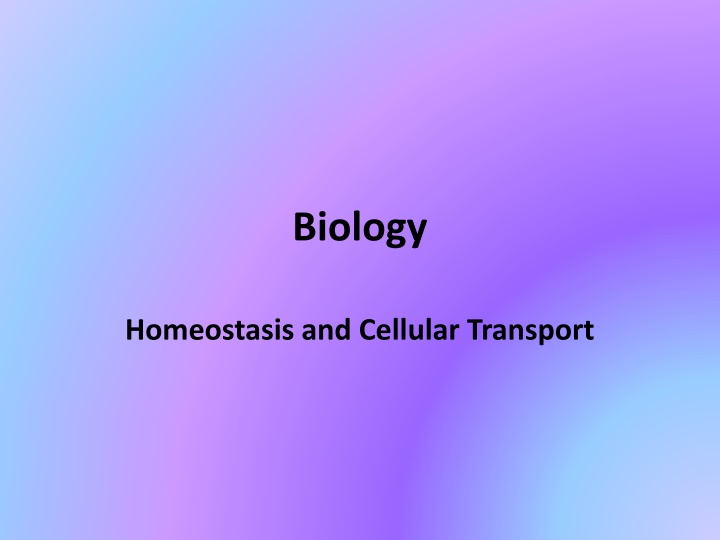
Understanding Cellular Transport and Homeostasis in Biology
Explore the concepts of homeostasis and cellular transport in biology. Learn about the importance of maintaining internal balance, the structure of cell membranes, types of cellular transport, including passive and active transport, and mechanisms like diffusion and osmosis. Dive into the world of phospholipids, bilayers, and feedback loops that regulate these vital processes.
Download Presentation

Please find below an Image/Link to download the presentation.
The content on the website is provided AS IS for your information and personal use only. It may not be sold, licensed, or shared on other websites without obtaining consent from the author. If you encounter any issues during the download, it is possible that the publisher has removed the file from their server.
You are allowed to download the files provided on this website for personal or commercial use, subject to the condition that they are used lawfully. All files are the property of their respective owners.
The content on the website is provided AS IS for your information and personal use only. It may not be sold, licensed, or shared on other websites without obtaining consent from the author.
E N D
Presentation Transcript
Biology Homeostasis and Cellular Transport
Homeostasis Literally means, inner balance Keeping internal conditions within healthy limits It applies to things like body temperature and blood pressure
Feedback Loops or Homeostatic Mechanisms
Cellular Transport Cellular transport describes how substances cross the cell membrane. As you remember, the cell membrane controls what goes in and out of the cell.
Phospholipids The cell membrane is made mostly of phospholipids They have a hydrophilic head and hydrophobic tail Hydrophilic means water loving Hydrophobic means water fearing
Phospholipid Bilayer The cell membrane is made of two layers of phospholipids It also contains some proteins The hydrophilic heads face the cytoplasm and extracellular fluid, while the tails face inward
Types of Transport Passive Transport Substances cross the membrane without the use of energy (ATP is the most used energy molecule in the human body) Active Transport Substances cross the membrane through the use of energy, or ATP
Passive Transport Diffusion - The movement of substances from an area of high concentration to an area of low concentration
Passive Transport Contd Facilitated Diffusion Diffusion that takes place using a membrane protein. They can open and close when needed.
Osmosis The diffusion of water.
Equilibrium After diffusion or osmosis has taken place and there is an equal concentration of substances.
Passive Transport Summary Passive transport usually moves things: 1. That are small 2. From high to low concentration 3. That are lipid soluble 4. Without using ATP
Active Transport Movement of substances across the cell membrane that requires the use of ATP (energy).
Types of Active Transport Protein Pumps A membrane protein and ATP are used to pump substances against their concentration gradient across into or out of the cell. Example - Na/K ATP pump ://www.brookscole.com/chemistry_d/templates/student_resources/shared_resou rces/animations/ion_pump/ionpump.html
Exocytosis and Endocytosis Special vacuoles called vesicles, and ATP are used to add and remove substances from the cell. http://highered.mcgraw- hill.com/olcweb/cgi/pluginpop.cgi?it=swf::535:: 535::/sites/dl/free/0072437316/120068/bio02.s wf::Endocytosis and Exocytosis
Exocytosis Substances in a vesicle are forced through the membrane using ATP and released in the fluid surrounding the cell.
Endocytosis Phagocytosis Cell eating, cells use ATP and a vesicle to ingest solid molecules Pinocytosis Cell drinking, cells use ATP and a vesicle to ingest liquids
Receptor Mediated Endocytosis Cells ingest molecules using ATP after they bond to special receptor proteins on the cell s surface.
Active Transport Summary Active transport can move things in a wide variety of ways, but certain situations must use active transport: 1. Moving large molecules 2. Moving from low to high concentration 3. Moving things that are not lipid soluble 4. All situations must use ATP
Tonicity Cells will react differently when placed into solutions with varying concentrations of substances, an idea known as tonicity.
Isotonic Solutions Equal concentration of substances inside the cell and outside. The size of the cell does not change.
Hypertonic Solutions Concentration of substances is greater outside the cell than inside. The cell shrinks as a result.
Hypotonic Solution Concentration of substances is greater inside the cell than outside. The cell swells as a result. If the concentration is great enough, the cell will burst(aka lysis).
